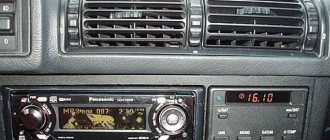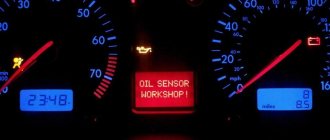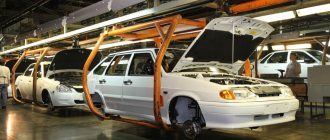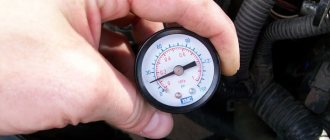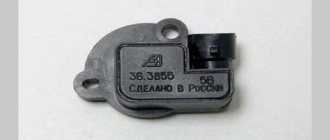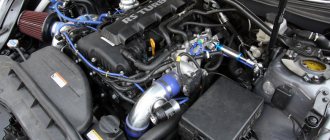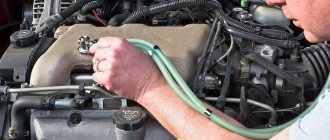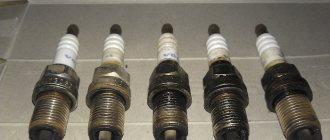Idle mode means that the engine is running in neutral. In this state, the torque from the engine is not transmitted through the gearbox to the drive wheels. At the same time, quite often drivers notice how engine vibrations noticeably increase at idle and are transmitted to the body. In its normal state, the engine practically does not vibrate, although minimal vibrations are allowed here, and they can be considered normal for a car. We must not forget that during the cold season, vibrations increase compared to engine operation in warm weather. When the engine warms up, the vibrations return to normal after a few minutes. If additional jerks, dips and omissions are not detected, everything is fine with the motor. The absence of extraneous noises and sounds is a pleasant signal for the motorist.
How to eliminate engine vibration at idle.
The engine vibrates strongly at idle: possible reasons
The normal operation of a serviceable motor requires minimal vibration, which is quite acceptable. It should also be taken into account that in the cold season the engine may vibrate somewhat more strongly. After 3-5 minutes of warming up, the vibration level should return to normal. In parallel with this, there should be no jerks, dips or omissions, as well as extraneous sounds in the engine operation.
The appearance of noticeable vibrations indicates that certain malfunctions are possible. Let us immediately note that increased vibrations are detrimental to the internal combustion engine, so such a problem must be diagnosed and eliminated as quickly as possible.
Among the main reasons why the engine begins to vibrate (shudder, twitch) at idle, experts identify the following:
- engine troits;
- problems with the correct mounting of the motor;
- faulty engine mounts;
- crankshaft imbalance;
For normal operation of the power unit, idle speed is usually around 750-950 rpm, which depends on the type of engine. Reducing the idle speed will cause the engine in this mode to start running less stable and may even stall at idle. An increase in speed naturally leads to increased fuel consumption, as well as an increased load on the CPG and other components of the internal combustion engine. As a result, motor life is reduced. For this reason, an optimal balance is maintained for each engine to achieve maximum efficiency and stability at idle.
Motor troits
If the engine starts to stall, then uneven operation of the cylinders is observed. The most severe engine vibration at idle is felt if one of the cylinders is not working. Pressing the gas pedal allows you to partially compensate for the resulting imbalance by increasing the crankshaft speed, but engine power will still be reduced.
The load on the crankshaft when the cylinder is not working or is misfiring remains uneven, which causes jerking and jerking of the engine. The driver usually feels a noticeable shudder and vibration in the steering wheel, which can also be transmitted to the body. The engine vibrates most strongly at idle, and also under load when driving at low speeds.
It is necessary to eliminate the problem with an inoperative cylinder as quickly as possible, since in addition to vibrations that destroy the engine, normal fuel combustion does not occur in the combustion chamber of the problem cylinder. As a result, excess fuel washes away the lubricant from the walls of the faulty cylinder, thereby increasing wear on its mirror. Also, on worn-out engines, there is a high probability of unburned fuel leaking through the seals, which leads to fuel getting into the engine oil and losing its beneficial properties. In this case, the engine wears out faster, cokes more, etc.
Additionally, it is worth noting the engine vibrations that appeared after replacing the timing belt. In this case, it is necessary to eliminate the possibility of an error when installing the belt, since a displacement of even one tooth leads to a violation of the valve timing. The result is engine malfunctions and engine tripping.
Mounting and malfunction of engine mounts
A common problem that causes increased engine vibrations is a defect in the power unit mounts. Most often, the problem lies in the engine supports (so-called mounts), which can become unusable over time. These pillows are a kind of dampers that not only hold the internal combustion engine, but also dampen vibrations.
Also, an increase in the level of vibrations can occur after replacing one or more pillows with products with greater rigidity.
You can diagnose the problem as follows. Invite an assistant and open the hood, then rock the car with sharp jerks by moving the car forward and backward. The assistant must record the angle and degree of engine deflection during such rocking. Normally, the engine should swing forward, backward, and also to the sides evenly and equally.
If deviations are detected, that is, the motor has a greater tilt in one direction, the corresponding motor mount will need to be replaced. Please note that experts recommend replacing engine mounts even if there are no visible defects or damage on the part itself. Also, after replacing the support, it is necessary to carefully adjust.
Balancing the crankshaft and CPG
During the process of repairing an internal combustion engine, which involves grinding or replacing the crankshaft, it is necessary to subsequently balance the part with the flywheel and clutch. To balance the crankshaft, specialists drill out extra grams in its body. It is also necessary to weigh the pistons, piston pins and other parts of the CPG before assembling the engine. Differences in the weight of parts can cause a serious increase in vibrations.
What else could cause this phenomenon?
If, after examining the operation of the fuel supply channels, ignition system, support cushions and understanding that all this is functioning normally, the engine continues to vibrate in neutral speed mode, then the reason is something else.
One possible option is a faulty gearbox. To determine the source of the problem, fully depress the clutch pedal. If the jerking goes away, the vibration is caused by the clutch or transmission.
Note! Similar problems can arise when a “mechanics” or “automatic”, as well as a variator or “robot” breaks down.
Incorrect operation of some on-board computer sensors responsible for controlling the power unit can also cause shaking in idle mode. Check the operation of the sensors:
- mass air flow;
- crankshaft position;
- Hall;
- idle speed.
Another option is familiar to owners of cars with small engines. If powerful consumers (climate control system, heated seats) are turned on in such vehicles while idling, the engine may experience increased vibrations. They disappear as soon as the driver presses the gas pedal. The same effect can occur if the generator is damaged.
Engine vibration at idle speed: main causes and solutions
One of the reasons for incorrect engine operation, leading to significant and expensive car repairs, is strong engine vibration at idle.
Timely diagnostics and subsequent measures taken to eliminate vibration can fully insure the car owner against many troubles, including not only the comfort and safety of car operation, but also significant financial investments in major repairs.
The operation of a serviceable engine implies the presence of minimal vibrations. When the air temperature drops, the motor may vibrate slightly more. However, after five minutes of operation, these fluctuations should disappear completely.
The appearance of fairly noticeable vibrations, skips, jerks, dips and/or extraneous sounds during engine operation indicates that the vibration mode is disturbed due to the occurrence of situations of a certain nature.
Problems with motor mounting
Another fairly common reason why the engine jerks at idle is its improper mounting (or a malfunction of one of the protective cushions). Usually, vibration in this case reverberates throughout the body.
It is quite simple to make sure that the problem lies here. True, for this you will need the help of a partner, who will alternately shift gears: neutral, reverse and forward. At this time, you need to open the hood and look at the engine deflection.
If the mount is installed correctly and the protective pads are not worn out, then the engine will tilt at the same angle each time. In this case, the supports themselves will be unloaded one by one. If the deviation in any direction greatly exceeds the norm, then the problem is in the mounting (the engine shakes). In this case, you will most likely have to replace the pillow.
Speed
This is 800-1000 rpm. If the number of crankshaft revolutions is lower, the engine will begin to stall; with a higher number, fuel consumption will increase and engine parts will wear out faster. It is worth noting here that in the cold season, slight vibration after start is a normal phenomenon, which disappears after 5 minutes as the power plant warms up. If the engine shaking does not disappear, it is necessary to consider the reasons for its occurrence.
Why is it important to install the timing belt correctly?
If vibrations occur after replacing the timing belt, it is quite possible that it was installed incorrectly. Let us remember that this is a drive belt that transmits rotation from the crankshaft to the camshaft. Thanks to him, the gas distribution system, i.e. valve, works synchronously with the strokes of the piston system. If the belt is installed incorrectly, for example, there is a shift of at least one tooth, the valves begin to open and close at the wrong time.
This leads to dips in engine operation and tripping. Accordingly, at idle, as in the case of a faulty ignition, there is a strong vibration, which is clearly felt on the steering wheel and the entire body. The problem can be solved by correctly installing the belt. Therefore, it is advisable to replace it only in service centers.
Engine mounting
Strong vibration of the engine at idle speed can be caused by poor fastening of the power plant to the body. In some cases, it is possible to identify breakdowns of the protective cushion through which the motor is attached. It is advisable to carry out diagnostics together with an assistant, who will sequentially switch gears in the gearbox. An observer looking under the hood will identify which gears are causing problems.
Even after replacing the airbags, the shaking does not always leave the car. This is due to the need to properly configure and adjust the fasteners.
Failure can occur for any of the four supports (rear, front, bottom or top). However, practice shows that the most vulnerable is the front support. It is subject to increased static and dynamic load. As soon as one of the pillows breaks, then if no measures are taken, the rest will quickly break .
For novice drivers, vibration in the steering wheel at idle is not always obvious, so we recommend periodically undergoing diagnostics in specialized workshops or from experienced technicians. Otherwise, trouble cannot be avoided. If you decide to look for the cause yourself, then you need to use the method of exceptions, moving from simple to complex causes.
Primary diagnosis of causes
If the car's power plant is working properly, vibration is not felt during idling. When it appears, and it is also intense, transmitted to the body and felt even inside the car, it is worth conducting diagnostics to determine the cause of what is happening and correct its elimination. To do this, depress the clutch and listen.
If the vibrations continue, it means that the motor is really faulty, but if they stop, there may be problems in the operation of the gearbox and the clutch itself. Moreover, the type of gearbox, whether it is automatic or mechanical, does not play any role. In any case, it is necessary to urgently go to a service station and show the car to specialists, because professionals should be involved in repairing the power unit and putting the transmission in order.
By the way: you can check the condition of the gearbox yourself. To do this, you need to pour a small amount of oil into a container and examine its condition. The presence of metal shavings in lubricants, the presence of impurities and a burning smell indicate a serious gearbox malfunction. If the oil is normal, most likely the vibrations at idle are caused by clutch failure.
A common cause is also the incorrect operation of individual engine components. In this case, shaking is felt immediately after starting the engine and even when it stops. In such situations, experts recommend paying attention to the following:
- Engine airbag (it may be faulty).
- Condition of the fuel filter (clogging).
- Fuel pump clogged.
- Condition of the spark plugs (it is possible that they will have to be replaced).
- Components of the cylinder-piston group.
Balancing the cylinder-piston group and crankshaft
Often, during repair work on a power unit, it is necessary to grind the crankshaft or replace it. This leads to weight changes. It usually becomes higher than with the old part. So that after this the engine does not tremble at idle, balancing is performed - to balance the balance of the crankshaft with the clutch mechanism and the flywheel. This is done by drilling out parts of the part to reduce weight.
Vibration may be a consequence of installing new elements of the cylinder-piston assembly. Especially if they have a different weight compared to old components. To prevent weight changes from leading to increased shaking of the running engine, it is necessary to weigh the parts of the cylinder-piston system before assembling the power unit.
Vibrations of a car diesel unit
If the car uses a diesel unit, its vibrations at idle can be explained by slightly different reasons. The reasons for this “symptom” will depend on the engine design, but usually they are:
- The injection advance angle is incorrectly set;
- There are malfunctions in the operation of diesel injectors, timing belt or high pressure pump;
- There is a scattering of compression in the cylinders;
- General malfunction of the cylinder-piston group or individual cylinders.
Unlike their gasoline “brothers,” diesel engines have normal idle speeds around 680-780 rpm. Most often, vibrations are caused by different compression in the cylinders, but after warming up and increasing the thermal clearances, the vibrations disappear. However, it is still worth measuring the compression.
A shift in valve timing observed after replacing the timing belt is guaranteed to lead to an imbalance in the operating cycle of the engine. This problem cannot be ignored, and it is not rare either. Otherwise, the reasons should be looked for in the same place as for a gasoline engine. True, problems associated with injectors and fuel pumps are observed much more often. Added to this is another cause of vibration: improper adjustment of the high-pressure pump.
Danger of vibrations
The causes of vibrations that occur must be eliminated as soon as possible after the first signs of problems occur. This is explained by the fact that after vibrations, other problems often develop that can cause enormous damage to your vehicle. As experts themselves note, the greatest damage due to vibrations is caused to the car body. The first to wear out and break are the plastic elements, then gradually all sorts of fastenings, located sometimes in very hard-to-reach places, become loose. When the car shakes for a long time, the paint layer may begin to deteriorate. This already entails the formation of corrosion and the spread of rust throughout the body.
We must not forget about the harm that is caused to the power unit. The engine also suffers significantly from unnecessary vibrations. Vibration causes accelerated wear of parts, destroys the packing in the crankshaft, and then oil begins to leak. As a result, the engine cannot produce the required number of revolutions, the car accelerates more slowly, and fuel consumption increases significantly. And at the same time, engine power decreases, which negatively affects control. If you noticed that the car began to vibrate, but were able to find the reasons and eliminate them, the work is not yet completed. In addition to this, be sure to check all the parts that could have been damaged in any way as a result of the vibrations that have arisen. You can eliminate the source of vibration, but you cannot exclude the fact that some destructive processes have already been launched. The fastener has come loose, the paintwork has been damaged, and therefore new problems will potentially arise soon.
At a certain speed
If there is vibration in the car at high speed, the cause may be faults in the following components:
- transmission;
- steering system;
- suspension.
If vibration occurs in the body at a speed of 100–120 km, check the silent block on the suspension arms and ball joints. Failure of units is associated with driving on bad roads and frequent falling into potholes.
Wear of the shock absorber spring and strut support bearing leads to the car shaking when driving on uneven areas at speeds above 80 km per hour.
Wheel imbalance is the first cause of steering wheel shaking from 50 to 100 km/h. Driving at high speeds with such a malfunction is impossible and dangerous.
Wear of the steering tip will lead to the formation of large play in the unit, this will create an imbalance of the front wheels, leading to shaking of the car at speeds of 90 km/h.
We recommend: Is it possible to eliminate the hum in the power steering on your own?
If the vibration is caused by the transmission, it is easy to check. While driving, you should depress the clutch on a manual transmission; on an automatic transmission, set the handle to the “N” position. If the shaking stops, the problem is diagnosed in the gearbox unit.
Vibration at idle
Vibrations are the rattling sounds produced by the engine and felt by the driver when he holds the steering wheel.
If there are problems with the engine, the rattling from barely perceptible becomes very strong and unpleasant.
Signs
The main symptoms of this problem include:
- increased vibration of the steering wheel, which can be transmitted to the engine body;
- engine popping;
- engine jerks and failures;
- The tachometer readings exceed the permissible values for the car.
It will also be useful for you to know why the car shakes during acceleration and at high speed.
Causes
The main causes of engine vibrations include:
- engine tripping (uneven operation of the pistons or failure of one of them);
- incorrect motor mounting;
- faulty engine mounts;
- the crankshaft is unbalanced;
- the fuel system is dirty;
- improper fastening of other units;
- ignition system malfunction.
- One of the common mistakes associated with engine mounts is installing mounts from different materials.
The above reasons are valid for gasoline cars.
The reasons why the vibrations of a diesel engine have increased, due to the difference in design and operation from a gasoline engine, are slightly different:
- malfunction of the cylinder-piston group or gas distribution mechanism as a whole or in a separate cylinder;
- compression variation in cylinders;
- malfunction of the high pressure fuel pump, diesel injectors or timing belt teeth;
- incorrect injection advance angle.
Why is low engine idle dangerous?
No less a problem is reducing idle speed.
Low speeds can lead to the following consequences:
- fuel detonation in the cylinders does not occur completely;
- oil dilution;
- washing off the lubricant;
- coking of the motor.
It is also worth noting that at low idle speeds the car will stall, as it will not have enough revolutions to maintain operation. This, in turn, will increase the load on the ignition system, increasing wear on the car and reducing its service life.
Diagnostics
To carry out diagnostics, you should pay attention to the following points:
- check the injector/carburetor;
- take readings from the tachometer and pressure sensor and compare them with normal values;
- check the fastening of the motor and other components;
- run computer diagnostics of the car (if there are appropriate electronics on board).
Separately, it is worth mentioning the process of checking engine mounts, since their incorrect installation quite often causes problems, although they are easily diagnosed and corrected.
Important! Since visible problems may hide other, more serious ones, if any problems occur, you should contact a car service center.
Checking the airbags is carried out as follows: one person sits behind the wheel, opens the hood and drives back and forth in place, the second person watches the engine at this moment - it should tilt evenly in all directions. If the engine rolls a little more in one direction, then the cushion on that side should be replaced.
What measures to take in case of strong vibration
When faced with strong vibrations, you can begin to combat the problem.
Engine adjustment
Adjusting the motor, first of all, includes checking the fastenings of the parts, as well as their condition. Having ensured that they are in good working order and correctly secured, it is necessary to calibrate their joint work.
The best way to do this is to check the factory settings in the instructions and reset all settings to them. Tuning includes not only tuning the operation of the engine itself, but also related systems - fuel supply, ignition, and so on.
If parts have been replaced, it is necessary to ensure that the parts in weight and material match those that were replaced - otherwise imbalance will occur.
Did you know? If the crankshaft is too heavy, it is lightened by cutting out holes, thereby knocking off the extra grams.
Correct installation of the timing belt
Another important element in solving the problem is installing the timing belt. The belt is responsible for the connection between the crankshaft and the camshaft, and its incorrect installation will inevitably lead to disruption of the gas distribution system.
The belt is replaced as follows:
- the protective belt cover is unscrewed;
- disconnects from the sensor;
- checking the coincidence of the marks on the camshaft gear (or shafts, if there are several of them), the gas distribution mechanism drive, the flywheel, the crankshaft - this will ensure the correct valve timing;
- the old belt is removed;
- a new belt is put on: first on the crankshaft pulley, then on the camshaft gear and pump;
- two revolutions of the crankshaft are carried out, after which the marks are checked - if the belt is installed correctly, they will coincide.
Correct sequence of actions
When a driver discovers that the engine of his car begins to twitch at idle and vibrate, there is no need to immediately panic and disassemble half the car. Act sequentially, from the most likely causes to the least possible.
- First, check the condition and functionality of the spark plugs. If there is no large amount of carbon deposits on the surface, and a good spark is formed, you can move on to the next possible source of vibration problems at idle.
- Engine compartment. Here you need to make sure that all support cushions and engine mounts are in good condition and there is no damage. The gear shift method will help here. This way you can track which direction the slope is going and whether the motor mount is really broken.
- The next step will be to check the fuel system. You should see how clean it is and whether any contamination has formed there. Be sure to check the condition of the filters. If they become dirty and are already in a fairly worn condition, it is better to change them. It definitely won't harm the car.
- Software and injectors. This is true for injection engines, where sometimes you just need to update the current software of the electronic control unit. If this is not necessary, simply clean the injectors. It’s not the most common cause of vibrations at idle, but it shouldn’t be ruled out either.
- When all the previous points do not apply to your situation, it is worth checking the weight distribution of the CPG and the calibration of the crankshaft. It is not recommended to deal with these issues on your own. It is better to visit a trusted car service center. Solving such problems requires the presence of special, complex and expensive equipment. Buying it for personal use is not particularly profitable. And if a person without the proper experience and qualifications intervenes in the weight distribution of the CPG or the calibration of the crankshaft, his mistakes can lead to even more serious consequences.
The problem of engine vibrations when idling is familiar to a large number of drivers. Only some people ignore the uncharacteristic behavior of their vehicle, while others try to quickly understand the reasons and eliminate them. It is easy to guess which of the two positions is correct. Try to listen to your car, monitor its behavior and condition, take timely measures and eliminate malfunctions in the early stages of their occurrence. It is better to prevent a breakdown than to repair the car later. Nowadays repairs are not so cheap.
Disorders in the nutrition system
Ultimately, they come down to improper formation of the composition of the combustible mixture. Typically, vibration at idle is a consequence of its depletion. It is possible to understand exactly which node or element is the source of the problem only with the help of special equipment. There are many reasons, below are just a few of them:
- fuel pump failure;
- contamination of the filter and (or) fuel line;
- clogged jets in the carburetor or nozzles in the ramp;
- incorrect carburetor settings, faulty sensors in the injection engine, etc.
Vibration when driving under load
There is another type of vibration - under load.
The appearance of vibrations while driving not at idle speed of the engine, but under load, always indicates problems in the operation of the engine. The occurrence of such an unpleasant phenomenon is preceded by various reasons.
Chassis imbalance
If the wheels are not balanced correctly, this becomes evident when driving at speeds of 70 km/h and above. Moreover, the force of shaking can be so noticeable that it is transmitted and felt even on the steering wheel. The problem can be solved extremely simply - by visiting a service station and balancing the wheels.
The procedure is accessible and does not take much time. It is important to note that imbalance often occurs in winter, in bad weather, when wet snow sticks to the disks, but vibrations in this case are more noticeable than on poorly balanced wheels.
Fuel system clogged
Problems that lead to engine shaking also occur due to malfunctions in the fuel system, in particular due to its clogging. They consist of problems with the fuel supply, which is why the fuel mixture is formed incorrectly. Vibrations are usually noticeable if the mixture in the cylinders is lean.
Carrying out accurate diagnostics in the current situation is possible only with the use of special equipment, and we are talking about the diagnostics of both carburetor and injection internal combustion engines. Often the problem is a faulty fuel pump or clogged fuel filters.
And also in clogged fuel injectors, unadjusted carburetor. Typically, diagnostics of the fuel supply system are performed after it has been verified that the ignition is working properly, and also that the cause of the vibration is not a broken engine mount.
Sensor malfunctions
Engine malfunctions often result from failure of the sensors that send signals to the engine ECU. For example, if the lambda probe, idle speed control, speed indicator, etc. are faulty, the control unit operates in emergency mode, which is why there is a high risk of disturbances in the formation of the fuel mixture and the resulting unpleasant consequences.
The same thing will happen if the crankshaft position sensor, phase sensor, etc. break down. You can find out what exactly requires replacement only by performing computer diagnostics, as well as deciphering the error detected by the electronic controller.
How to reduce engine vibrations
If the car has a carburetor, then to reduce vibrations this element requires careful adjustment, after which the idle speed is set. At the same time, the fuel pump is checked.
On injection cars, the fuel pump, injectors, electronic control system sensors, and fuel pressure regulator in the fuel rail are also checked. Additionally, it is recommended to clean the throttle valve and check the idle air valve, which supplies air bypassing the throttle valve at idle. Vibration of a diesel engine at idle may indicate certain malfunctions of the fuel injection pump or injectors, which will also require careful diagnosis and subsequent adjustment.
Saving engine life
Remember: low speeds are more dangerous to a car engine than high speeds. Reducing the idle speed will lead to unstable operation of the unit and a rapid reduction in engine life .
If you are the owner of a car with a gasoline engine, try not to allow a further decrease in the speed already at around 2000 rpm. If the engine “does not pull”, for example, when trying to drive on hills, it is enough to switch to a lower gear. The appearance of vibrations is a very bad signal.
Also, do not forget that the service life of the engine and its adjacent components can be affected by seemingly unimportant details. For example, internal combustion engine airbags . Often they try to save money on replacing them by purchasing inexpensive analogues from Asian companies. Good and relatively inexpensive options can be found under the brand names Impergom, Boge, Lemfoerder, Ruville, Hans Pries (pay attention to the article number - the last symbols indicate the quality standard of the product). The same can be said about the choice of sensors, timing belts and fuel pumps - you should not skimp on them.
Best driving instructors:
Automotive instructor Svetlana Automatic transmission: Hyundai Accent Trains in Northern Administrative Okrug, North-Western Administrative Okrug, Khimki REVIEWS
Driving instructor Elena Automatic transmission: Chevrolet Lacetti Teaches in the Southern Administrative District, South-Eastern Administrative District, Vidnoye, Domodedovo REVIEWS
Driving instructor Marina Automatic transmission: Kia Cerato Manual transmission: Chevrolet Lanos Trains in Northern Administrative Okrug, Dolgoprudny REVIEWS
Automotive instructor Irina Automatic transmission: Kia Cerato Trains in SZAO, JSC REVIEWS
Driving instructor Natalya Automatic transmission: Kia Spectra Teaches in the Eastern Administrative District, Balashikha, Reutov REVIEWS
Driving instructor Oleg Automatic transmission: Chevrolet Lacetti Manual transmission: Chevrolet Lanos Trains in Northern Administrative Okrug, Dolgoprudny REVIEWS
Driving instructor Yana Automatic transmission: Kia Spectra Teaches in the Northern Administrative Okrug, Dolgoprudny REVIEWS
Driving instructor Yulia Automatic transmission: Chevrolet Lacetti Manual transmission: Chevrolet Lanos Trains in the Eastern Administrative District, South-East Administrative District, Lyubertsy, Reutov, Zheleznodorozhny REVIEWS
Automotive instructor Svetlana Automatic transmission: Chevrolet Lacetti Trains at Northwestern Administrative Okrug REVIEWS
Driving instructor Tatyana Manual transmission: Chevrolet Lanos Automatic transmission: Kia Spectr Teaches in Krasnogorsk REVIEWS
Driving instructor Peter Manual: Daewoo Nexia Trains at Northwestern Administrative Okrug REVIEWS
Automotive instructor Oksana Automatic transmission: Hyundai Accent Teaches in North-Eastern Administrative District, Mytishchi, Korolev, Pushkin REVIEWS
Driving instructor Dmitry Automatic transmission: Volkswagen Golf Manual transmission: Chevrolet Lanos Trains in North-East Administrative District, Northern Administrative District, North-Western Administrative District, Dolgoprudny REVIEWS
Driving instructor Oksana Automatic transmission: Kia Spectra Manual transmission: Chevrolet Lanos Trains in the Southern Administrative District, South-Western Administrative District, Vidnoye, Podolsk REVIEWS
Automotive instructor Dmitry Manual transmission: Lada Granta Teaches in the South-East Administrative District, Lyubertsy REVIEWS
Uneven engine torque
Strong vibration and the engine stalls. There are several reasons. The ignition wire (high voltage cable) is damaged, if our car has one, then the problem will be additionally related to the speed. Solution? New set of ignition wires.
Dividing finger problem. The metal inside is worn out or there is no necessary contact. Solution? New separator finger. One of the electronically controlled ignition coils has fallen. The car is also weakening. It is advisable that all four (if there are four on your car) are made by the same manufacturer and installed at the same time. Therefore, the entire set must be replaced at once. If, for example, two reels from one manufacturer and two from another were used, then after the first, the second pair will soon fall out. However, there are cars where four coils are locked and sold as one element.
When driving
If your vehicle experiences vibration at speed that increases as it accelerates and does not stop while driving, the problem may be wheel imbalance. In addition, shaking when driving is associated with a malfunction of suspension and electrical parts:
- shock absorbers, struts;
- support bearing;
- tie rod end;
- hinges;
- high-voltage wire break.
When a high-voltage wire breaks, the car begins to vibrate when driving and a characteristic crackling sound is heard. Finding the location of the breakdown is quite simple; a spark is noticeable when the engine is running and idling. But if the electrical wiring is in order, but the appearance of extraneous sounds under the hood is noticeable, you should check the electronic sensors.
Wheels are out of balance
Vibrations caused by the wheels are usually felt through the steering wheel. One possible culprit for this could be a worn or damaged wheel bearing. Although they should last quite a long time, as with any other mechanical part of the car, they can fail at any time.
Another thing to look for is rod ends or ball joints. If the steering wheel feels normal while you're driving straight, but starts to shake when turning, this could indicate worn rod ends. However, if the steering wheel shakes in a straight line but stops when you turn, this may be a sign that the ball joint is faulty and should be replaced.
Vibration can be another cause of vibration and shaking in your vehicle. The term refers to any deviation from a truly circular rotation and is measured by a special indicator.
Signs of Engine Vibration
On premium cars, especially if they have a multi-cylinder internal combustion engine, vibrations may not be felt on the body. All supports, fastenings, cushions are made of high quality material. In this regard, even turning off one cylinder does not particularly cause vibrations on other components. The engine seems to be isolated from the rest of the car.
Especially at idle, engine vibration affects the body of domestically produced cars. Also, in foreign-made cars with 4-cylinder engines, the impact on other components is felt.
Thus, the imbalance is always transmitted to the body and the gearbox handle. Let's look at how to identify and eliminate vibrations in engine components on a car with your own hands.
Vibrations in diesel engines
In addition to the main factors, increased vibrations at idle in diesel units are caused by malfunctions in other parts of the vehicle structure. The stable operation of these internal combustion engines strongly depends on the condition of the parts and components of the fuel supply system, for example, on the degree of their contamination. Contamination occurs due to particles and impurities (including water) from the fuel and air entering the fuel system components due to poor filtration.
The culprit for increased oscillations may be a malfunction of the fuel supply system components and, first of all, the injection pump.
If vibration is felt the first time after starting a cold engine, but disappears after warming up, then the glow plug is faulty. In addition, the serviceability of the engine should not be excluded from the list of reasons - the presence of a compression level that meets the standards.
Diesel vibration at idle
At first glance, everything is simpler here: there are no spark plugs, no distributors. However, the “shaking” of a car equipped with a diesel engine indicates more serious and “costly” problems:
- Failure of the injection pump, which can only be checked using special equipment.
- Injector contamination. Their cleaning is carried out in specialized technical centers.
If vibration occurs at idle, checking the diesel unit should begin by determining the compression in the cylinders. If it does not meet the standard, the mixture will not ignite and the engine will begin to shake. The second stage of testing is to check the alignment of the marks on the power unit cover and the camshaft pulley. If the injection angle is incorrect, the diesel engine will operate unstably.
Dual mass flywheel
Symptoms of damping flywheel failure:
- creaking, grinding noise when starting and stopping the power unit;
- rumbling sound when the engine is idling;
- vibration transmitted to the body and interior (with non-critical wear only in cold weather).
The reason for this behavior is the backlash of the elements of the spring-damper system, which is designed to dampen torsional vibrations. On cars with manual transmission, to check the flywheel, just squeeze the clutch. If the engine begins to run smoother and vibrations have decreased, it means that the reason for unstable idling is the dual-mass flywheel. The owner of a car with a robotic gearbox is left to rely on indirect signs and defects after disassembly.
Knocking and uneven operation when cold
Accelerated wear of cylinders and pistons is a real problem for many owners of Volkswagen and Skoda cars with gasoline engines. Recently, cases of scoring in cylinders on Hyundai cars have become more frequent. Due to the tendency to lighten the CPG elements, reduce the thickness of the piston rings, the flame zone and the length of the skirt, repositioning the pistons is associated with heavy loads. Local overheating associated with operating a car in traffic jams (disturbed air flow, long periods of idle time), improper engine warming up in winter, lead to wear of the CPG.
As a result, the engines begin to knock when cold. As it warms up, the knocking, and with it the increased vibration in the body, stops.
Balancing methods
There are a couple of ways to balance a particular part:
- Static method;
- Dynamic method.
Each of these methods has its own characteristics.
Static balancing - performed without forced rotation of the part. This method does not require expensive equipment; it can be used in a garage. However, it should be remembered that the imbalance is not completely removed using a static method. The essence of the method is that the part to be balanced is mounted on prisms or bearings. The element then rotates around its own axis, at the end of the rotation it takes a position in which its heavier side will be located below the axis of rotation
It is important to note that the prism must be strictly horizontal, and the bearings must rotate with minimal resistance. Then the heavy side will outweigh the light side, and the part will deviate from the center because of this
Dynamic crankshaft balancing
Dynamic balancing - this method requires the use of constant rotation of the part using special equipment. This method allows you to completely get rid of imbalance, and the method can be used for the most rigid parts of any size (such as the crankshaft, cardan, flywheel, and others). All data on deviations is provided by the computer with high accuracy. By dynamically balancing the parts of the crankshaft, wheel hub, clutch basket and brake drums (or discs), the heavier side is lightened by removing material from it. It all depends on the type of product, whether drilling or other mechanical processing is performed.
Damage (wear) of engine support pads
The cushions also wear out, more or less depending on the operating conditions of the machine. Vibrations and sometimes strange jerks while driving can be immediately attributed to problems with the airbags. The cushions wear out faster if the car is used not only on highways and city roads. Solution? Change pillows. They are completely different on different models and types of cars. It happens that there are two different types of pillows under the engine at the same time. They wear out, break, dry out and simply burst. If vibration is reflected on the side rear view mirrors or shaking is transmitted to the door handle in the cabin, first of all we inspect the cushions under the gearbox or engine.
There are no miracle recipes. Only if the damper is dirty, it is usually enough to spray it with a special agent and run the system with it for several minutes. But in other cases you will have to contact car service specialists.
There are many recommendations, but still vibration is different. A good specialist will measure the current to rule out a problem in the electrical circuit, test your car for vibration while driving, and evaluate the range of movement of the engine compartment and the transmission of this vibration to the body and steering wheel.
In a used car that is quite young, vibrations occur as it is used, this is a normal phenomenon for the car and simply requires routine repairs and replacement and maintenance of some consumables.
We have looked at the most common problems that cause car vibration, but there are many more of them and yours may be personal. For example, an unsecured load in the trunk gives an unpleasant feeling of shaking and tapping somewhere in the back.

